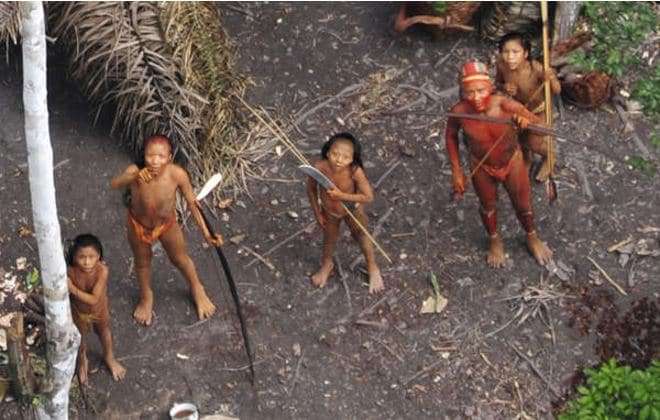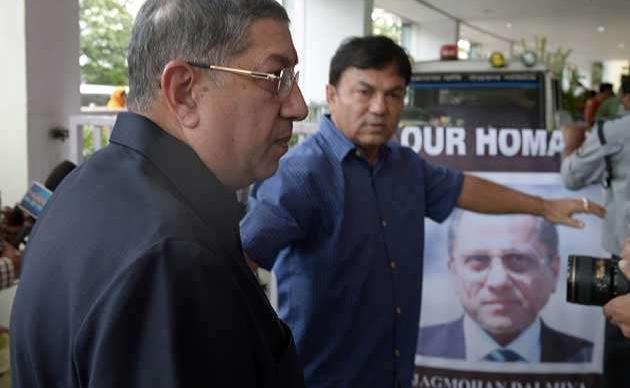September 11, 2017
The outside world might never have heard about the suspected massacre if not for some barroom boasting by a group of miners fresh from working an illegal gig in the Amazon jungle.

The garimpeiros had bragged that they’d come across members of a reclusive, uncontacted Amazonian tribe near Brazil’s border with Peru and Colombia, authorities say.
September 11, 2017
The outside world might never have heard about the suspected massacre if not for some barroom boasting by a group of miners fresh from working an illegal gig in the Amazon jungle.

The garimpeiros had bragged that they’d come across members of a reclusive, uncontacted Amazonian tribe near Brazil’s border with Peru and Colombia, authorities say.
The tribe members were greater in number — there were as many as 10 — but the gold miners said they’d gotten the better of them and killed the entire lot, said Carla de Lello Lorenzi, communications officer for Survival International in Brazil.
The miners cut the tribe members’ bodies so that they wouldn’t float, Lorenzi said, then dropped them into the Jandiatuba River.
The miners had collected tools and jewelry from the indigenous dead, corroborating their story.
An unidentified person who overheard the story was disturbed by it, recorded the miners’ conversation and turned the audio over to authorities. They have since launched an investigation into what, if confirmed, would be one of the largest mass murders of uncontacted people in decades.
Advocates for stricter protective measures say the suspected massacre is evidence that the Brazilian government isn’t doing enough to safeguard the more than 100 vulnerable tribes that have never made contact with the outside world — and have no desire to.
“If these reports are confirmed, [Brazilian President Michel Temer] and his government bear a heavy responsibility for this genocidal attack,” said Survival International’s director, Stephen Corry. Corry said the government has slashed funds for an agency that protects the tribes, leaving them “defenseless against thousands of invaders — gold miners, ranchers and loggers — who are desperate to steal and ransack their lands.”
#Brazil investigates alleged massacre of Indigenous Amazon #forest dwellers https://t.co/e8z21dzjcq#gold#mining@Survivalpic.twitter.com/XhAimIASgm
— David Kaimowitz (@DKaimowitz) September 9, 2017
“All these tribes should have had their lands properly recognized and protected years ago — the government’s open support for those who want to open up indigenous territories is utterly shameful, and is setting indigenous rights in Brazil back decades.”
According to the New York Times, the government closed five of the 19 bases it uses to monitor uncontacted tribes and prevent incursions by miners and loggers.
Three of the closed bases were in the Javari Valley, home to more uncontacted tribes than anywhere else on Earth.
For obvious reasons, little is known about the indigenous group involved in the suspected killings.
Locally, Lorenzi said, they’re known as Fleicheros, or “the ones who throw arrows,” but their language and customs — and how they interact with at least two other uncontacted tribes in the immediate area — remain a mystery.
But the tribe members are not the only people in that part of the Amazon, Lorenzi said. It is illegal to mine there, but prospectors have brought earth-moving equipment to the area, leaving giant craters that can be seen from the sky.
They also bring violence, according to the government, which says garimpeiros are responsible for threats, child prostitution and killings.
Even their nonviolent presence in the protected lands can be dangerous to uncontacted tribes, which lack the immunity to fight the diseases that miners and loggers bring.
Any contact can be contentious and even violent, with the uncontacted usually getting the worst of it because, as Lorenzi told The Post, “it’s usually bows and arrows against guns.”
Details about those contacts remain hazy, because they involve two groups of people unlikely to speak to authorities.
Still, tales of the worst violence sometimes get out. Survival International documented the story of Marisa Yanomami and Leida Yanomami, survivors of the Haximu massacre in 1993:
“The gold-miners killed our brothers and sisters and also killed our father with machetes; some of them were killed with guns,” they told the organization. “After the first 10 people died, at the start of the war, we moved to another place to hide and stayed in our shabono (communal house), but the next day, the miners appeared again.”
In a statement on its website, the Brazilian National Indian Foundation, or Funai, said it had prompted the federal public prosecutor’s office to investigate the most recent allegation.
The government has also trumpeted its latest operation against incursions on protected lands. In August, it shut down an illegal mining operation. Soldiers destroyed four dredging machines and fined mining operators $1 million for environmental crimes.
Investigations are tough undertakings. The site of the suspected killing, for example, is a 12-hour trek by boat during the dry season. And it involves a group of people with their own language and a centuries-long wariness of outsiders.
Even the details of the killing are sketchy, Lorenzi said. And the vacuum of information speaks to another fear advocates have: that these types of violent interactions happen a lot more frequently than is reported.
“That’s highly probable, yes, because it’s so difficult to document,” she said. “It’s the uncontacted versus illegal miners who think they can get away with anything.
“Unfortunately, a lot of the time they do.”
Courtesy/Source: Washington Post
















































































































